5 Common Historic Painting Techniques & How to Identify Them
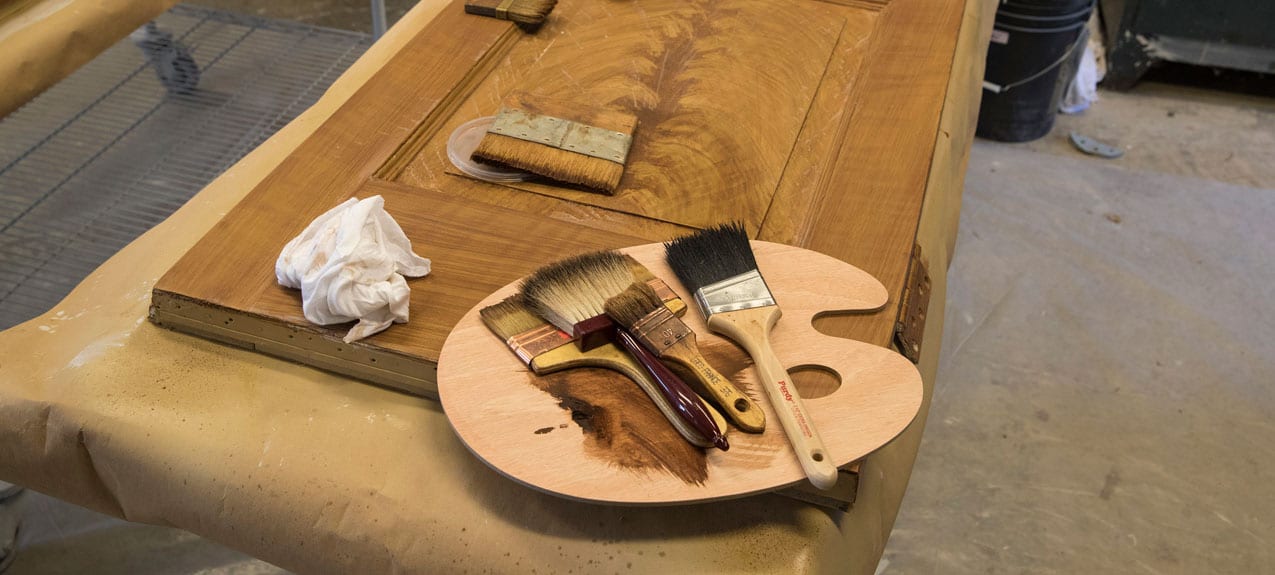

Artisans and craftsmen have for generations studied key artistic principles that form the bedrock of the decorative arts: Fitness, proportion, harmony, and the importance of the relationship between color and the architecture it resides in.
For this reason, historic painting and decorative finishes were thoughtfully selected and placed within a structure to relate to—and enhance—the architecture.
“All ornament should consist of enrichment of the essential construction of the building”—A.W. Pugin
FREE RESOURCE:
Identifying Historic Paint: A Guide to the Significance of Paint in Historic Structures
The apprenticeship system was a passing down of knowledge, materials, and techniques from one generation to the other, i.e., from journeyman to apprentice. Apprentices would learn techniques from seasoned journeymen and they would, in turn, continue to share their knowledge with those who came after them. This knowledge and skill could relate to everything from specific application techniques to the ability to understand the rudiments of paint chemistry and create finishes that would provide a sense of beauty and harmony.
It is through this continual passing and refining of skill that the architectural arts came into being, and continue to be passed along to this day.
When working on a preservation or restoration project, identifying the historic finishes and techniques used to create a piece of art is key to understanding the intent of the original artist/decorator. Below, we explore some of the more common examples of common historic painting techniques that were used.
1. Semi-Transparent Finishes: Glazes and Scumbles
The terms glaze and scumble are often confused, but understanding the difference between the two, and their different uses, are key to reinstating the intended finish during a project.
A scumble is a thinned-down, opaque paint, that can be manipulated and applied over a painted ground. It is most often associated with faux finishes such as woodgraining.
A glaze is a semi-transparent color, in oil or water, which is applied over another painted finish to enhance or modify it; for example, to change the color, tone, or appearance. The degree of transparency is controlled by the ratio of pigment to the medium. The surface may be manipulated with various textures such as stippling, rag-rolling, etc.
The manipulation of the scumble or glaze depends on the intended features. For example, a “glaze and wiped” effect may be used on bas-relief to add depth and dimension to the ornament. The glaze is applied and the highlights are wiped. A stipple glaze may be applied to modify a color while providing an even distribution. A blue with a yellow glaze would modify it to a blue-green color.
In the Bay View Room of the Maritime Museum in San Francisco, exposures revealed a stippled ombre transition of color. A base color of a cerulean blue was applied and was gradually blended wet-on-wet to take it from a dark shade of cerulean blue to a lighter shade. A stippled provided the transition of color. In this case, rather than a glaze, a linseed oil paint modified the color. But the same method of application was used. This blended effect may also be achieved with modern day glazes.
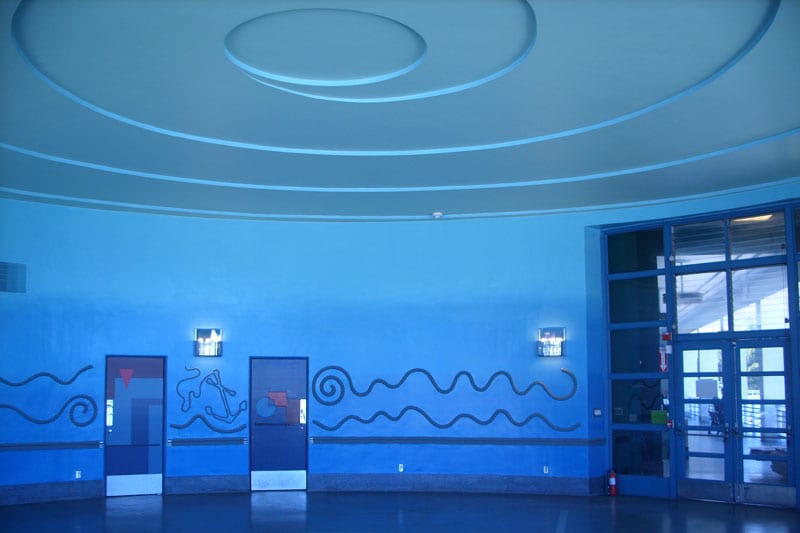

2. Woodgraining (Faux Bois)
Woodgraining was historically applied to imitate woods that were not readily available. The graining was executed expertly to imitate the intended wood, such as mahogany, walnut, or quarter-sawn oak.
The steps involved in woodgraining include: Scumbling, flogging, curling, mottling, and other effects that may provide the appearance of the wood. The overall tone and color can be adjusted with a thin application of glaze.
Specific tools are used, such as floggers and steel graining combs, badger hair softeners, pencil over grainers, etc. Expert grainers were able to use these tools to manipulate the various scumbles to match the characteristics of the wood in grain and cut.


3. Marbleizing (Faux Marbres )
Marbleizing, similarly to wood graining, was used to imitate genuine marble for economic reasons. Considering the space it was intended for, marbleizing is often executed at architectural features such as pilasters and columns.
A multi-step process, marbling uses a combination of scumbles and glazes to add depth and body to the marble. This allowed the artisan to capture the natural features and characteristics that could be found in genuine marble.
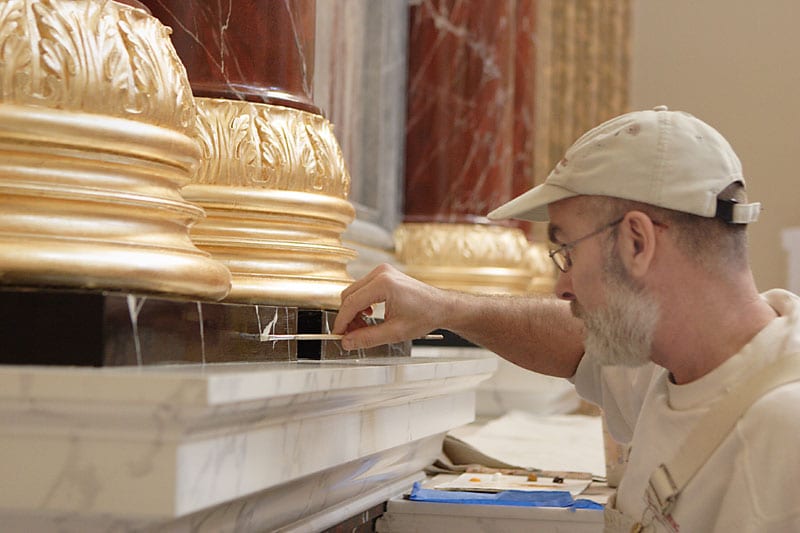

4. Stenciling
A stencil is a cut out pattern or “pierced” design that can be cut from various materials such as thin cardstock, foil or metal, paper. Today, we cut our stencil plates from Mylar or acetate.
The stenciled decoration (which could consist of a single plate or multiple plates) can be as ornate as the decorator chooses, as long as he considers the placement and relationship to the architectural features. With stenciling, knowledge in proportion was essential in developing the layout and design of the stencil.
Using guidelines, stencil brushes, pallets, and adhesive, the stencil is applied directly to the wall or surface. The craftsmen took care into laying out the stencil and ensuring the paint was an appropriate consistency to provide crisp designs.
Stenciling is a repetitive and mechanical process, and is capable of providing a variety of decorative effects. Often, banding and striping is incorporated into the stenciling process.
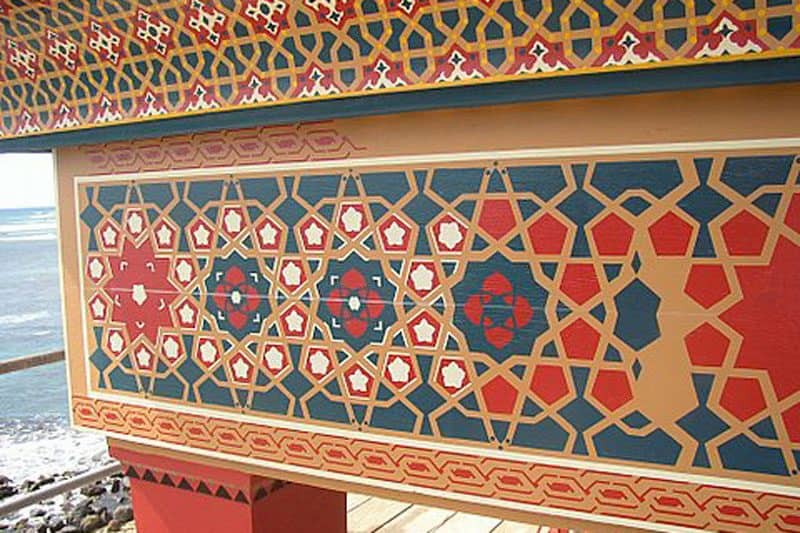

5. Simulated Architectural Mouldings, or Trompe L’oeil
Trompe l’oeil is a French term which translates into “fool the eye” or “deceive the eye.”At its simplest, it can be described as an optical illusion in paint.
It can be used in a variety of ways, and in architecture, is most often used to provide three-dimensional depth to a two-dimensional surface. Tromp l’oeil may be used to create mouldings, columns, or architectural supports.
Trompe l’oeil is created through a series of mid-tones, highlights, and shadows. The design is applied to the surface, first with the mid-tone, and the highlights and shadows are then added to develop the dimension. Considering the angle of the lighting, the highlights and shadows shifted appropriately throughout the room as it would if it were truly three-dimensional.
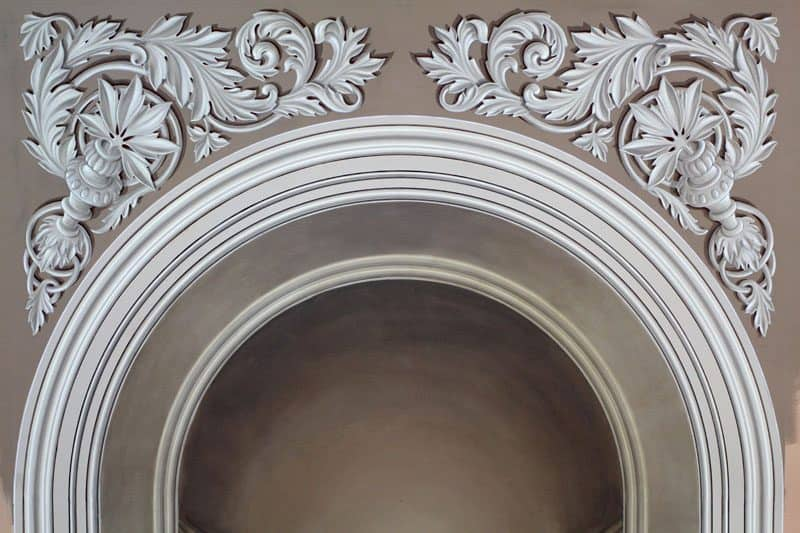

Does the Finish Relate?
Over the years, as ownership and stewardship of many of today’s historic buildings shift from one hand to the next, historic finishes and decoration are painted over or otherwise lost. That is why it is so important to not only consider the architecture of the building, but to look beneath the surface in these historic structures in order to determine if particular finishes are present, or if hidden decorative elements may exist.
